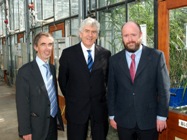First Minister visit

L to R. Professor Noel Lloyd, First Minister Rhodri Morgan and Dr Michael Abberton during the visit to IBERS
03 October 2008
First Minister visits Aberystwyth University
First Minister Rhodri Morgan was at Aberystwyth University on Thursday 2 October to see some of the latest developments at the Institute of Biological, Environmental and Rural Sciences and the Visualisation Centre.
Accompanied by the Vice-Chancellor, Professor Noel Lloyd, the First Minister met with Professor Mervyn Humphreys, Dr Steve Fish and Dr Michael Abberton at IBERS Gogerddan. Professor Humphreys and Dr Abberton discussed their work on legumes and ways of reducing the use of nitrogen, and Dr Fish focused on work to produce ethanol and commercially relevant chemicals from grass by a process of fermentation.
After lunch the First Minister was given a guided tour of the Visualisation Centre by Mr David Craddock, Commercial Director of the University's Commercialisation and Consultancy Services. This was followed by a meeting with Professor Mike Wilkinson and Professor Will Haresign at the Penglais laboratories of IBERS.
Speaking after his visit, the First Minister said:
“This was a great opportunity for me to learn more about how Welsh Assembly Government funding is being used in these two very different fields of academic research. In July this year, the Welsh Assembly Government announced a multi-million pound investment towards the development of the Institute for Biological, Environmental and Rural Sciences here in Aberystwyth.
“This is probably the biggest investment ever undertaken in one hit in Welsh science. I was pleased to see at first hand some of the significant research which is undertaken here, relevant to the whole sustainability and climate change agenda.
“It was also interesting to learn more about the work of the Visualisation Centre which provides an important service to small businesses in Wales.
“Research in academic centres takes you so far, but we in Wales need to learn how to commercialise that research and turn it into spin-out businesses and leverage in match funding from the private sector and international partners to expand our science and science-based industry.”
Professor Noel Lloyd, Vice-Chancellor welcomed the visit;
“The formation of IBERS is an important strategic development in the University and for science capacity in Wales. I am therefore delighted to have this early opportunity to welcome the First Minister to see some of the research work that is being undertaken. The new Institute is extremely well placed to respond to the important global challenges in food and water security and sustainable land use. Through its contribution to research and its emphasis on innovation, IBERS will have an important economic impact in mid Wales and beyond. The developments at the Visualisation Centre also demonstrate the way in which the university's research interface with the needs of industry and commerce”
In July 2008 the National Assembly Government announced that it was contributing £23.5m towards a five year development programme that will see £55m being invested by Aberystwyth University in new research and teaching facilities and the creation of scientific and management posts. This followed the merger of the former Institute of Grassland and Environmental Research into Aberystwyth University in April 2008 and the formation of the Institute of Biological, Environmental and Rural Sciences.
The IBERS vision is to develop scientific research that will have practical applications in addressing major challenges such as climate change, food and fuel security and animal and plant diseases. With more than 300 staff, over 1,000 undergraduate and post graduate students and an annual budget of more than £20 million, it is one of the largest research and teaching groups working in this field in Europe.
Opened in October 2007 the Visualisation Centre received £6m from the National Assembly Government, including a £4.4 as part of the European Union’s Objective 1 programme. With support from industrial partners Sun Micro Systems and Silicon Graphics Inc, the centre offers high powered computer equipment that enables small businesses to turn their ideas into reality using 3D visualisation technology. It also offers a valuable resource for academic research and was recently credited with creating the World’s first 3D images of the Sun.



